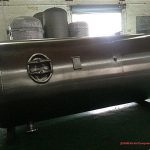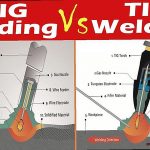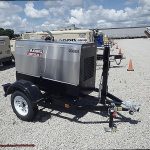Look no further than the Lincoln Vantage 300. This powerhouse of a machine has been making waves in the welding world for its impressive performance and versatility.
But before you invest in this top-of-the-line model, there’s one question you may be wondering: how much does it weigh? We’ve done some research and are excited to share all the details with you.
So let’s dive into this blog post and uncover the truth about the weight of the Lincoln Vantage 300.
Comparison Table – 322 vs. 300
Contents
The weight of welding equipment is a crucial consideration for professionals in the field. As an expert welder, I have witnessed many struggles with transporting heavy equipment to different job sites. This section will delve into the weight differences between two popular models – the Lincoln Vantage 300 and 322 – to assist you in making an informed decision on which one best suits your needs.
Firstly, let us closely examine the specifications of these two welders. The Lincoln Vantage 300 is a diesel-powered engine-driven welder with a rated output of 300 amps at 100% duty cycle. This versatile machine is capable of performing various welding processes and weighs approximately 1125 lbs (510 kg) without fuel or oil. In comparison, the Lincoln Vantage 322 is also a diesel-powered engine-driven welder but with a slightly higher rated output of 325 amps at 100% duty cycle. It has a weight of around 1280 lbs (581 kg) without fuel or oil.
From these specifications, we can observe that the Lincoln Vantage 300 is marginally lighter than the Lincoln Vantage 322, weighing about 155 lbs (70 kg) less. However, it is crucial to consider all possible configurations and additional accessories that may affect the weight of these welders. For instance, adding options such as remote controls and cable racks can increase the weight of both models, making them more comparable in terms of weight.
Furthermore, while the Lincoln Vantage 300 may be lighter, it is still a hefty piece of equipment that may require a forklift or crane for transportation. On the other hand, the Lincoln Vantage 322 has built-in lifting points that make it easier to move around job sites. Therefore, when making a decision, the portability of these welders may play a more significant role than just comparing their weight.
Lincoln Vantage 322 vs. Lincoln Vantage 300
Look no further as we delve into the details of two popular models – the Lincoln Vantage 322 and the Lincoln Vantage 300. As a seasoned welder, you understand the importance of having the right equipment to complete a job efficiently and effectively. But with so many options available in the market, it can be challenging to make a decision. Let’s break down these two welders and help you determine which one is the ideal choice for your welding needs.
Size Matters: The Compact Vantage 322 vs. The Larger Vantage 300
When it comes to welding machines, size and weight matter. The Lincoln Vantage 322 boasts a compact and lightweight design, making it a breeze to transport and maneuver on job sites. This feature is particularly beneficial for construction teams, pipe rig owners, and rental fleet managers who often have to move their equipment to different locations. However, if power output is your priority, then the larger and heavier Lincoln Vantage 300 might be your go-to choice. Depending on your operation size and needs, both machines have their advantages.
Power Output: Multi-Process Capabilities vs. Higher Output
Both the Lincoln Vantage 322 and the Lincoln Vantage 300 pack an impressive punch in terms of power output. However, they differ in their capabilities. The Vantage 322 offers Multi-Process capabilities, allowing for various applications to be completed with just one machine. Not only does this save time, but it also cuts down on expenses by eliminating the need for multiple pieces of equipment. On the other hand, the Vantage 300 has a higher output, making it suitable for heavy-duty welding applications that require maximum power.
Portability: Stainless Steel Enclosure vs. Innovative Service Access
Aside from its compact size, the Lincoln Vantage 322 also boasts a durable stainless steel enclosure, providing protection against harsh job site conditions.
Lincoln Vantage 322
The Lincoln Vantage 322 welder is a compact and formidable machine, perfect for a variety of welding applications. As a specialist in this specific model, I have delved into research to gather crucial information on its weight and fuel tank capacity, and how these elements affect its portability and convenience. So, let’s delve into the intricate details of this welding powerhouse together.
First and foremost, let’s discuss the weight of the Vantage 32Tipping the scales at approximately 1,150 pounds (522 kg), this machine may not be the lightest in its series. In comparison to its sibling, the Vantage 300, which weighs around 950 pounds (431 kg), the 322 model carries an additional weight of roughly 200 pounds. However, it still boasts a lighter load than other models in the Vantage series, including the Vantage 400 (1,270 pounds/576 kg) and Vantage 500 (1,710 pounds/775 kg).
But do not be disheartened by the weight. The Vantage 322 makes up for it with its impressive fuel tank capacity of 17 gallons. This translates to longer run times and increased productivity, making it a sought-after choice for heavy-duty welding tasks.
In comparison to other brands, the Vantage 322 generally carries more weight than similar models from Miller Electric or ESAB. For instance, the Miller Big Blue® 400 Pro weighs only around 930 pounds (421 kg), while the ESAB Warrior™ has a weight of approximately 1,040 pounds (472 kg). However, as we know, weight is not the sole factor to consider when selecting a welding machine.
Portability is another crucial aspect to take into account. The Vantage 322 may be heavier than some of its competitors, but its compact size allows for easier maneuverability on job sites. Furthermore, it boasts convenient lifting points for effortless transport and a robust wheel kit for fluid movement.
Lincoln Vantage 300
Welding is a vital process in many industries, and having the right equipment can significantly impact the final result. That’s where the Lincoln Vantage 300 comes into the picture – a compact yet robust welding machine that has quickly become a favorite among welders. In this article, we’ll delve into the intricacies of its weight and portability, and why it’s a dream machine for many welders.
Let’s start with the weight aspect. The Lincoln Vantage 300 weighs approximately 1150-1180 pounds, depending on the specific model. While this may seem heavy, it actually falls on the lighter side when compared to other similar welding machines. For instance, the Miller Big Blue 400 weighs around 1400 pounds, making it heavier than the Vantage 300. Even the popular ESAB ArcMaster 401 tips the scale at around 1200 pounds. So what sets the Lincoln Vantage 300 apart in terms of weight?
The secret lies in its compact design. Despite its powerful capabilities, the Vantage 300 boasts a smaller frame, making it easier to transport and maneuver on different job sites. This feature is especially advantageous for welders who frequently move their machines or work in confined spaces. Its lighter weight also means less strain on your back when loading and unloading it from your truck or van.
But don’t be fooled by its lightweight nature – the Lincoln Vantage 300 is a force to be reckoned with when it comes to performance. With a maximum output of 300 amps and a duty cycle of 100%, it can handle heavy-duty welding tasks with ease. Plus, its fuel tank capacity of up to 12 gallons ensures long hours of uninterrupted welding.
The weight of the Lincoln Vantage 300 is perfectly balanced for its size and power output, making it a top choice for welders across various industries.
Lincoln Vantage 322 vs. 300: Similarities
When it comes to the art of welding, having the proper equipment is crucial for achieving top-notch results. This is where the Lincoln Vantage 322 and 300 welders come into play. These two models have gained a reputation for their compact designs, Multi-Process capabilities, quiet operation, and durability, thanks to their stainless steel enclosures and industrial Kubota® diesel engines.
One striking similarity between the Vantage 322 and 300 is their compact size. These welders are specifically designed with portability in mind, making them the perfect choice for construction teams, pipe rig owners, and rental fleet managers who are constantly on the move. Moreover, both models boast Multi-Process capabilities, allowing for a wide range of welding applications with just one machine. This makes them incredibly versatile and suitable for any welding project that may come your way.
The Vantage 300 is also a great value for its compact size. It delivers remarkable performance and efficiency without compromising on power or features. Speaking of power, both models are equipped with industrial Kubota® diesel engines that not only offer durability but also operate quietly. This is particularly beneficial for those working in noise-sensitive environments.
Lastly, the stainless steel enclosures on these welders provide an added layer of resilience, shielding them from harsh weather conditions and wear and tear. This makes them reliable companions for any welding job, no matter how demanding the circumstances may be.
In conclusion, whether you opt for the Lincoln Vantage 322 or 300, rest assured that you are getting a top-of-the-line welding machine that is both compact and powerful.
Lincoln Vantage 322 vs. 300: Differences
As a welder, you understand the importance of having the right equipment to produce top-notch results. The Lincoln Vantage 322 and 300 are two highly acclaimed models that are often compared for their exceptional capabilities. However, what sets them apart? In this blog post, we will delve into the crucial differences between these two welders to assist you in making an informed decision.
Weight and Portability
One of the primary distinctions between the Lincoln Vantage 322 and 300 is their weight. The Vantage 322 weighs 1,135 pounds, while the Vantage 300 is slightly lighter at 1,050 pounds. While this may seem like a minor difference, it can have a significant impact on transportation. The Vantage 300’s lighter weight makes it easier to maneuver on job sites and load onto trucks or trailers. This makes it a more convenient option for welders who are constantly on the move or need to relocate their equipment frequently.
Size and Dimensions
In addition to weight, these welders also vary in size and dimensions. The Vantage 322 measures at 45 inches in length, 28 inches in width, and 35 inches in height, while the Vantage 300 measures at 33 inches in length, 22 inches in width, and 28 inches in height. This means that the Vantage 300 takes up less space than its counterpart, making it a better choice for those with limited space on job sites or in storage.
Performance
Despite the weight difference, both the Vantage 322 and 300 offer similar engine outputs and welding capabilities. This implies that performance may not be significantly affected by choosing one over the other. Both models also come equipped with built-in lifting eyes for portability, but due to its lighter weight, the Vantage 300 may be easier to lift and move around.
Conclusion
In conclusion, the Lincoln Vantage 300 stands out as the ultimate welding machine, offering unparalleled performance and versatility.
Its compact design, multi-process capabilities, and reliable performance fueled by an industrial Kubota® diesel engine make it a top choice among welders in various industries. While its weight may raise concerns for some, its advanced features and value for investment far outweigh any potential drawbacks.
Its impressive specifications and dependable performance make it a powerhouse in the welding world.





